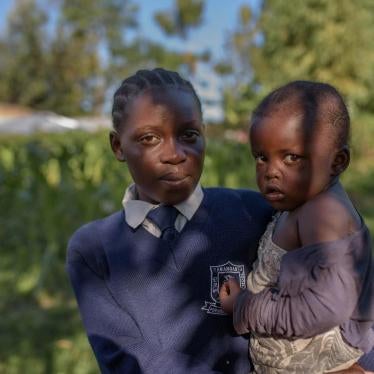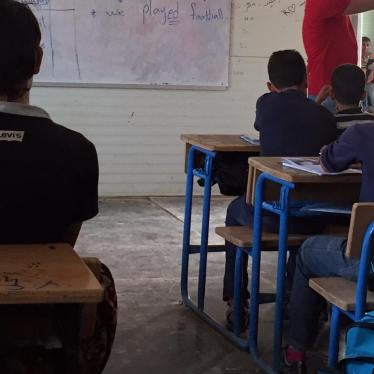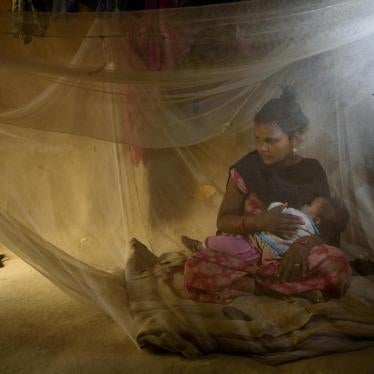Dear members of the Committee on the Rights of the Child,
We are writing on behalf of Human Rights Watch in response to a January 2016 open letter directed to the Committee regarding child labor and the minimum age of employment.[1] In particular, the letter argues against a minimum age of employment and urges the Committee to omit any reference to the International Labour Organization Convention concerning the Minimum Age of Admission to Employment (Convention No. 138) in its planned General Comment on Adolescents. We have serious concerns with the arguments put forth in the letter, and offer our analysis and recommendations below.
Human Rights Watch has been conducting research and advocacy on child labor since 1994. We have conducted child labor investigations in countries in every region,[2] and interviewed hundreds of children working across a wide range of sectors, including domestic work, gold mining, silk production, and the cultivation and harvesting of banana, sugarcane, tobacco, cotton, and other agricultural crops.[3]
Like most child rights advocates, we agree that work by children appropriate to their age and under healthy and safe conditions can contribute positively to their development. However, we do not believe that removing minimum age restrictions for employment is in the best interests of children.
In response to the January open letter, we would like to point out the following:
- A minimum age for employment does not prohibit children from working.
By establishing the minimum age of employment at age 15 (or 14 for developing countries), Convention No. 138 allows adolescents to combine work with school, or alternatively, to work fulltime if they have completed school and working conditions are not hazardous. Convention No. 138’s light work provision allows children between 13 and 15 (or alternatively, 12-14) to perform light work for up to 14 hours a week. The Convention does not prohibit children of any age from doing chores in their own household – an important avenue for learning responsibility – on family or small-scale farms, or work performed as part of vocational training in school. In sum, Convention No. 138 allows children many opportunities to gain skills and earn income. Its goal is to prevent children from working at ages that are too young or for hours that can harm their development or schooling.
- Work at young ages or for too many hours can be harmful.
The authors of the open letter claim that children can benefit from work even if they are below the minimum age set for “light work.” Although there may be benefits in some instances, many studies have found that work by young children or long hours of work are harmful to both their schooling and future earning potential. For example, research across 11 countries in Latin America found that in all 11 countries, working children performed significantly lower in school than their non-working counterparts, scoring up to 17 percentage points lower on tests of language and math.[4] Longitudinal studies in Tanzania found that work by children between 7 and 15 had a significant and negative effect on their probability of completing primary school.[5] These studies are consistent with Human Rights Watch’s findings. Many of the working children interviewed during our research reported missing school and having difficulty concentrating in school or completing their homework because of the demands of work. As a result, many perform poorly, are held back and forced to repeat grades, or drop out altogether.
An illustrative case is the United States, which has not ratified Convention No. 138 and sets 16 as the basic minimum age of employment[6] in all sectors except agriculture, where the minimum age for working on large farms is 12 and where there is no minimum age for employment on small farms. As a result, hundreds of thousands of children work in US agriculture at ages that are prohibited in every other sector. According to government estimates, these children drop out of school at four times the rate of other children.[7]
Although children who work may experience economic benefits over the short term, research finds that children who enter the workforce at an early age end up with less education and lower earnings as adults.[8] Girls are more adversely affected than boys by entering the labor force early. Furthermore, these wage disparities between males and females increase the younger the child begins to work.[9]
- Government responsibility extends beyond banning child labor.
Critics of Convention No. 138 and efforts to ban child labor argue that if children are not allowed to work, they and their families will end up worse off. Children often work to help impoverished families meet basic needs or because schools are not available or are prohibitively expensive. Banning child labor without addressing these root causes would be deeply problematic. However, the obligation to end child labor does not exist in a vacuum. All states parties to Convention No. 138 are also party to the Convention on the Rights of the Child. As such, they are obligated not only to prohibit child labor, but also to ensure children’s rights to free primary education, accessible general and vocational secondary education, and an adequate standard of living.
Strengthening efforts to alleviate family poverty and increase access to education will do more to improve the lives of children than allowing young children to work. In recent years, many states have made great progress in increasing children’s enrollment in school, expanding access to education, and alleviating family poverty through social protection programs. Programs that provide poor families with a guaranteed monthly income—often known as “cash transfer programs”—have proven successful in reducing family poverty, increasing school enrollment, and reducing child labor. The implementation of cash transfer programs is credited with lifting out of poverty 5 million people in Brazil and 60 million people in India.[10] Meta-analyses of cash transfer programs have found that beneficiaries of such programs are 23 to 41 percent more likely to be in school than their counterparts.[11] Many countries have also increased school enrollment by eliminating school fees, providing school meals, improving school transportation, and covering the costs of books, uniforms, and other associated school expenses. Such initiatives also can lead to significant reductions in child labor. For example, in little more than a decade, Morocco used several of these strategies to boost the number of children completing primary school by more than 20 percent[12] and dramatically reduced child labor rates from 9.7 percent to 2.5 percent among children ages 7-15. [13]
- Eliminating a minimum age of employment may put children at greater risk.
Children, for various reasons, are less able than adults to negotiate with their employers for safe, healthy, and fair work environments. The pressure of family expectations can also cause children to endure exploitative or abusive conditions that adults would not accept. For example, Human Rights Watch has interviewed children who were beaten and forced to work for 18 hours a day by their employers, but did not report it to their families or authorities because of a sense of family obligation.[14] Many children also had no idea where to report employment-related abuse or violations.
Our experience working on child labor around the world makes us deeply skeptical that governments have the will or capacity to ensure safe and decent working conditions for children under the existing minimum age of employment. Many governments already fail to adequately enforce existing laws that set a minimum age of employment and prohibit the worst forms of child labor. We believe it is unlikely that these same governments would conduct adequate monitoring for even younger children, should existing minimum ages be lifted. Although some children may benefit from working in good conditions, the lack of legal protections may leave many others at risk.
Perversely, eliminating a minimum age for employment may actually encourage child labor. While poor families may understandably be tempted to send their underage children to work in order to meet other basic needs, eliminating the legal prohibition may make them more likely to do so.
- Enforcing a minimum age does not preclude urgent efforts to end the worst forms of child labor.
Critics argue that enforcing a minimum age of employment diverts attention, energy, and resources from “truly serious” workplace abuses and that “abolition” efforts would be better spent improving conditions of work for children. In practice, most child labor inspection regimes simultaneously enforce minimum age laws as well as prohibitions against hazardous work. One does not preclude the other. To the contrary, we would argue that focusing resources on improving working conditions for young children is much less beneficial than investing those resources in improving family livelihoods and access to quality education.
- Governments should not be encouraged to cherry-pick international law.
Signers of the open letter suggest that the Committee should omit any references to Convention No. 138 in its General Comment on Adolescents. This suggests that both states and child rights advocates can pick and choose the international law they deem “legitimate.” The authors also state that “any application of ILO 182 (the Worst Forms of Child Labour Convention) would need to take into consideration the local contexts where children work to make sure that children’s best interests are always served,” suggesting, if taken to its logical conclusion, that there are contexts where child slavery, child sexual exploitation, the forced recruitment of children for armed conflict, or hazardous work by children is acceptable. We reject such a notion.
The growth of both international human rights and labor law over the past decades has produced a robust body of international standards to protect children. These standards are complementary and should be enforced consistently and in concert. Asserting that some aspects of international law are legitimate while others can be disregarded sets a dangerous precedent.
We urge the Committee to reaffirm the importance of Convention No. 138 as a legally-binding standard that protects and advances children’s rights. We would be happy to communicate further with members of the Committee regarding Human Rights Watch’s work on child labor and the concerns expressed in this letter.
Sincerely yours,
[1] Bree Akesson et al., Open letter to the Committee on the Rights of the Child, January 27, 2016, available at: https://www.opendemocracy.net/open-letter-better-approach-to-child-work (accessed April 1, 2016).
[2] Brazil, Egypt, El Salvador, Ecuador, Ghana, Guatemala, Guinea, India, Indonesia, Kazakhstan, Mali, Morocco, Pakistan, Philippines, Tanzania, Togo, and the United States. We have also investigated the forced or compulsory recruitment of children for use in armed conflict—one of the worst forms of child labor—in more than a dozen additional countries.
[3] See Human Rights Watch, “Child Labor,” https://www.hrw.org/topic/childrens-rights/child-labor (accessed April 1, 2016).
[4] V. Gunnarson, P. Orazem, and M. Sanchez. “Child Labour and School Achievement in Latin America,” World Bank Economic Review, (2006), vol. 20:1, http://elibrary.worldbank.org/doi/abs/10.1093/wber/lhj003 (accessed April 1, 2016), pp. 31-54.
[5] K. Beegle, R. Dehejia, R. Gatti and S. Krutikova, The consequences of child labor: evidence from longitudinal data in rural Tanzania, Policy Research working paper no. WPS 4677, World Bank, 2008, http://documents.worldbank.org/curated/en/2008/07/9698636/consequences-child-labor-evidence-longitudinal-data-rural-tanzania (accessed April 1, 2016).
[6] Children of age 14 and 15 can work in certain limited jobs for limited hours.
[7] According to the US Department of Labor National Agricultural Workers Survey, 33 percent of US-born farmworkers had dropped out of school in 2005-2006. By comparison, the national drop-out rate during that period was 8 percent, according to the US Department of Education.
[8] See P. Emerson and A.P. Souza, “Is Child Labor Harmful? The Impact of Working Earlier in Life on Adult Earnings,” Discussion Paper No. 3027, Institute for the Study of Labor September, 2007, http://ftp.iza.org/dp3027.pdf (accessed April 1, 2016); see also Ilahi, Nadeem, Peter Orazem and Guilherme Sedlacek, “The Implications of Child Labor for Adult Wages, Income and Poverty: Retrospective Evidence from Brazil,” Mimeo, Iowa State University, 2001.
[9] E. Gustafsson-Wright and H. Pyne, “Gender Dimensions of Child Labor and Street Children in Brazil.” Policy Research Working Paper No. 2897, World Bank, 2002, https://openknowledge.worldbank.org/handle/10986/19228 (accessed April 1, 2016).
[10] E. Fultz and J. Francis, "Cash transfer programmes, poverty reduction and empowerment of women: A comparative analysis," GED Working Paper 4/2013, International Labour Organization, 2013, http://www.ilo.org/gender/Informationresources/WCMS_233599/lang--en/index.htm (accessed April 1, 2016).
[11] United Nations Educational, Scientific and Cultural Organization (UNESCO), Education for All 2000-2015: Achievements and Challenges, (Paris: UNESCO, 2015), p. 90.
[12] Ibid.
[13] Morocco High Commission for Planning, “Information note of the High Commission for Planning on the occasion of the World Day against Child Labour,” (“Note d’information du Haut-Commissariat au Plan à l’occasion de la Journée mondiale contre le travail des enfants”), June 12, 2012.
[14] See, for example, Human Rights Watch, Lonely Servitude: Child Domestic Labor in Morocco, November 2012, https://www.hrw.org/report/2012/11/15/lonely-servitude/child-domestic-labor-morocco.








